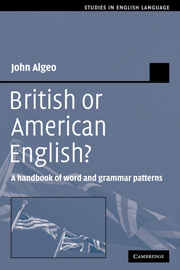Book contents
- Frontmatter
- Contents
- Preface
- Acknowledgments
- Introduction
- Part I Parts of Speech
- Part II Syntactic Constructions
- 11 Complementation
- 12 Mandative constructions
- 13 Expanded predicates
- 14 Concord
- 15 Propredicates
- 16 Tag questions
- 17 Miscellaneous
- Bibliography of British book citation sources
- Bibliography of studies, dictionaries, and corpora
- Index of words
- Frontmatter
- Contents
- Preface
- Acknowledgments
- Introduction
- Part I Parts of Speech
- Part II Syntactic Constructions
- 11 Complementation
- 12 Mandative constructions
- 13 Expanded predicates
- 14 Concord
- 15 Propredicates
- 16 Tag questions
- 17 Miscellaneous
- Bibliography of British book citation sources
- Bibliography of studies, dictionaries, and corpora
- Index of words
Summary
Focus
A number of patterns are available for focusing information in a sentence, and of those patterns, several seem to be particularly characteristic of British English.
1. The specific subject of the sentence may be stated first as an isolated noun phrase, followed by the sentence with a pronoun representing that subject in its normal position. This pattern emphasizes the subject as the topic of discourse. In effect this pattern says, “Here's what I'm talking about, and this is what I'm saying about it.”
<Doreen, she only works part time down the betting shop.> 1995 Jones 132.
2. The specific subject of the sentence may be shifted to the end of the sentence as a tag, leaving a pronoun in its normal place at the beginning of the sentence. This pattern also focuses an item (the subject) that is normally old information. In effect it says, “Here's what I'm saying, and this is what I'm saying it about.” Cf. CGEL 18.59.
<She was a right old so-and-so, his mum.> 1992 Charles 128.
This pattern is also used in questions.
<Will it take long, the tea?> 1986 Oct. Peter Barnes's adaptation of G. Feydeau's Scenes from a Marriage, Barbican, London.
If the subject that is extraposed as a tag is a pronoun identical with the one in the subject position, the effect is one of emphasis and perhaps annoyance.
- Type
- Chapter
- Information
- British or American English?A Handbook of Word and Grammar Patterns, pp. 305 - 312Publisher: Cambridge University PressPrint publication year: 2006



